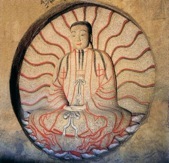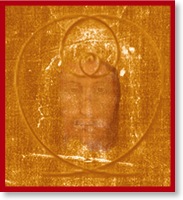Rainbow Body-Body of Light
Bṛhadāraṇyaka Upanishad
असतो मा सद्गमय
तमसो मा ज्योतिर्गमय
मृत्योर् मा अमृतं गमय
ॐ शांति शांति शांति - बृहदारण्यक उपनिषद् 1.3.28.
Transliteration:
Asato Ma Sat Gamaya
Tamaso Ma Jyotir Gamaya
Mrityor Ma Amritam Gamaya
Om Shanti Shanti Shanti.
Translation:
Lead Us From the Unreal To Real,
Lead Us From Darkness To Light,
Lead Us From Death To Immortality,
AUM (the universal sound of God)
Let There Be Peace Peace Peace. - Brihadaranyaka Upanishad 1.3.28.
~~~~~~~~~
Rainbow Body Attainment
“Then the righteous will shine like the sun in the kingdom of their Father.”
~ Mathew, 13.43:
Stories of luminosity or saintly radiance are common among Christian saints, Sufis, Taoist sages, Hindu yogis, Buddhist mystics and indigenous shamans; several are historically documented and not metaphor.
I am talking about actual events where visible light actually emanates from the physical body. These events range from a goal around the head and or hands, to extreme cases where the physical form becomes a translucent bubble of light. These Transfiguration events from a Buddhist perspective is viewed as the "Great Completion" or the "Rainbow" or "Body" of Light attainment. These events are widely recognized as a sign of extreme sanctity in Buddhism and among the Bönpo of Tibet . Reports of this level of transmutation have been chronicled far into antiquity by traditional linages. These events are rare, yet even in modern times there are still reports filtering out.
Interestingly the Bön lays historical claim to a lineage of Dzogchen that pre-dates the entry of Buddhism into Tibet. Rainbow or Body of Light attainment is not limited to Buddhism, as I started out by saying stories of luminosity abound in all the great religions of the planet, but to understand the process we turn to the rationalist Buddhist of Tibet and the well documented and delineated practice of Dzogpa Chenpo or simply Dzogchen.
In the Himalayan regions, the early indigenous religion was that of the Bön. Bön pre-existed the creation of both the sovereign territories, later to become the country of Tibet as well as of Buddhism. When the great Indian tantric sage Padma Sambhava brought Buddhism from India to Tibet in the 8th Century AD he found the richly tilled ground of the Bönpo. This land and its peoples took easily to the Buddha’s teachings and the Buddhist beliefs melded well with the rituals of the Bön.
When Padmasambhava left at the end of his time in physical form he dissolved his body completely back to their natural elements leaving no relics behind. At that moment a new lineage of Buddhist teachings was created. This was the start of what has become the Nyingma tradition and is the foundationof Tibetan Buddhism as we have come to know it.
At the heart of the Nyingma tradition is the practice of Dzogchen. Nyingma alludes to an ancient school, but this is simply because it is the oldest of the four schools of Tibetan Buddhism (Nyingma, Kagyu, Sakya, and Gelugpa). The Nyingma teachings are uniquely categorized in nine yanas, or vehicles. The main practices are emphasized in the three inner tantras of Maha Yoga, Anu Yoga, and Ati Yoga. Ati Yoga is also known as the Great Perfection, Dzogpa Chenpo, or simply as Dzog chen or Dzogchen. Dzogchen practitioners who have attained ultimate insight (wisdom) and compassion, a phase in which pure and total presence is stabilized (Trek-chod), are then allowed to practice To-gal.
To-gal is the final practice of Dzogchen. This final practice enables the master yogi or yogini to dissolve his or her physical body into the essence of the elements at the time of death. The master disappears into a body of light becoming the wisdom body, the term is called 'Ja'-lus or The Rainbow Body, in Tibetan. It has other names in other mystical traditions. This level of attainment is also the central aim of Indian Buddhist tantricism known as Vajrayana that the Taoists call the golden body. Another term is Soruba Samidhi, the golden body, a state of God-realization in which Divinity descends and transforms the spiritual, intellectual, mental, vital and physical bodies. It is considered physical immortality or the highest perfection.
The final process of dissolution of the body happens over varying amounts of time ranging from a short period to many days. During this process the body shrinks dramatically eventually down to only bits of hair, toe-finger nails, and possible nasal septum left behind. Some saints such as the great Milarepa (1050-1123) and Padmasambhava dissolved entirely into light, leaving no relics behind at all. The culmination of one’s life into the rainbow body is widely recognized as a sign of extreme sanctity. The process from these traditions is generally considered to take approximately seven days, during which time the body progressively shrinks in size. This shrinking is proportional and may stop at approximately small child size. The Rainbow Body - The Body of Light is light without shadow; it is awareness without obscurations; it is omniscience; it is pure space. It is the ultimate fruit of spiritual cultivation. The Body of Light represents a complete and total and radical transformation of one's status of being, a rediscovery of what was primordially present, and this condition is permanent. It is Awareness itself and is dependent on nothing else. This may be compared to the various Christian notions of transfiguration, resurrection, and ascension; but in the case of Dzogchen, the methodology of how this is accomplished, namely the realizing of the Body of Light, is presented in precise terms.
There exist in history many examples of the successful completion of this process. Even in recent years there have been a number of Tibetan Lamas, both Buddhist and Bönpo, who attained realization of the Rainbow Body ('ja-lus-pa) at the end of their lives and some of these occurrences were said to be witnessed by Chinese Communist officials.
Generally, there are three different ways in which this process may occur, they are in order of likelihood and again it is dependent on the individuals experience and abilities. In brief, after one is illuminated to their true nature they have the opportunity through practice of contemplation and visualization one consciously surrenders all aspects of identity, all karma, at the highest station is the "Great Transfer" into the "Kingdom of Light".
Rainbow Body of Light ('ja'lus) is attained at the time of death by means of Trekchod practice. One's
physical body rests uncorrupted, becomes luminous, begins to shrink and then dissolves in a shadow less flash of colorless light.
The "Body of Light" ('od-lus) is realized at the time of death by means of practice of Thodgal. One's physical body rests uncorrupted, becomes luminous, begins to shrink and then dissolves in a shadow less flash of colorless light.
The Great Transfer ('pho-ba chen po) is accomplished also by way of Thodgal, but there is no necessity of going through the process of dying. This is a conscious living act. Padmasambhava, Vimalamitra, and the Bonpo master Taphihritsa are all examples according to tradition, of individual masters who realized the Great Transfer. Often this event occurs rapidly with little or any time taken.
Trekchod practice, a releasing or a cutting through of all one's tensions and rigidities, all obscurations must be purified. This accomplished through mastering the art of contemplation and visualization. It is mastering meditation in the state of Union. It is a prerequisite for practicing the Thodgal practice. For a novice understanding it is a practice of witnessing ones karma and forgiving and dissolving it to the point it holds no power of cause. The physical body can be calmed to a death like state of samadhi. One then is able to consciously contemplate while in a deep state of union.
The practice Thodgal occurs in this deep state of contemplation union and is a practice of becoming the essence of all that is. Some say that the symbol of the lotus, the pure light of the moon, the symbol of HUM and the sound cosmic root sound of Hum all play a role at this level of practice. In essence this practice shifts identity to the Cosmic-Awareness. This is the practice some say occurring during those seven days. One integrates into the pure vision before one in space and becomes that vision through focused contemplation.
Often masters that attain the "Body of Light" will return one last time out of compassion for their beloved disciples and give what are known as posthumous teachings, delivered in the form of a last testament. Often the master is in the transfigured state on occasion suspended in the sky.
The Indian saint Sri Yukteswar writes in his book The Holy Science:
“In this state, all the necessities (of the heart) having been attained and the ultimate aim effected, (end of ignorance) the heart becomes perfectly purified (free from obscurations) and instead of merely reflecting the spiritual light (having life), actively manifests the same. Man, being thus consecrated or anointed by the Holy Spirit, becomes Christ, the anointed Savior. Entering the kingdom of Spiritual Light, he becomes the Son of God.”
Om Mani Padme Hum
for more read The Silent Gospel - The Science of Divinity - Creation of the Shroud of Turin
James Andrew Barrett
All Right Reserved Copyrighted
2007-2008-2009-2010-2011
-------------------------------------------------------------------------------
The Tibetan Book of Living and Dying ~ Sogyal Rinpoche Rider Paperback - 7 May, 1998 - Paperback - 440 pages new edition (7 May, 1998) Rider; ISBN: 0712671390
The Golden Letters : The Three Statements of Garab Dorje, the First Teacher of Dzogchen, Together With a Commentary Garab Dorje ~ John Myrdhin Reynolds (Translator)
Healing With Form, Energy, and Light: The Five Elements in Tibetan Shamanism, Tantra, and Dzogchen ~ Tenzin W. Rinpoche Snow Lion Publications Paperback - May 2002
Books on Bonpo Tradtion
Nine Ways of Bon ~ David Snellgrove
The Treasury of Good Sayings ~ Samten Karmay
Tibetan Bon Religion ~ Per Kvaerne
Yungdrung Bon - The Eternal Tradition ~ John Reynolds
